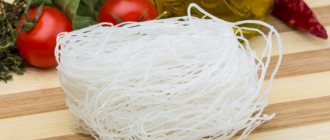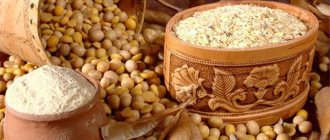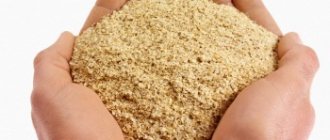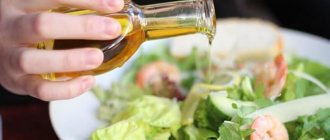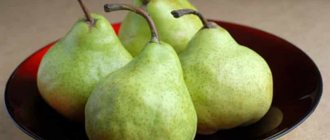What are rice noodles and their beneficial properties?
Many people think that rice noodles and funcheza are the same product, but this is not so. Rice noodles are made from rice flour, and funcheza is made from starch (bean, rice or potato). When cooked, rice noodles become white and funcheza is transparent, which is why they are called “glass”.
So, if until today you didn’t know whether you can eat rice noodles while losing weight, now we will tell you about its beneficial properties, based on which we will draw a conclusion!
Useful properties of rice noodles:
• Rice noodles contain no fat;
• Is an excellent source of vegetable protein (rice noodles + legumes = ideal dish for those who exercise a lot and do not consume milk, eggs, etc.);
• Useful for people who have hypertension and liver problems;
• Low calorie content of the finished product (approximately 120 kcal per 100 grams);
• Contains a large amount of complex (healthy) carbohydrates, which give us energy for a long period of time;
• Helps speed up metabolism (as it contains selenium, which in turn participates in metabolism and speeds it up);
• Restores strength after training;
• Contains rare vitamin PP (useful for the nervous system);
• Contains a complex of B vitamins (necessary for good metabolism, proper functioning of the heart, nervous system, etc.);
• Rice noodles are hypoallergenic;
• Removes excess water from the body (minerals contained in rice noodles help with swelling and cramps).
As you can see, rice noodles have a lot of positive properties, both for weight loss and health in general, so rice noodle dishes can be eaten on a diet, but do not forget about observing the consumption measures!
What is funchose
Thin rice noodles are increasingly used as a side dish during dieting. It has been proven that funchose for weight loss enhances the body's metabolic processes. This is due to the fact that the composition of glass noodles is about 20% resistant starch (which is not converted into glucose) remains in the intestines and becomes food for bacteria (fermentation process). By processing noodles, the body receives the necessary fatty acids, absorbs calcium and magnesium more easily, the level of glucose and cholesterol gradually decreases, and fat accumulations are “burned.”
Properties of glass noodles:
- vitamins B, D, macroelements;
- consists of complex carbohydrates that give a long-lasting feeling of fullness;
- amino acids contribute to the creation of new cells;
- no gluten;
- correct balance of BJU.
What is funchose made from?
Funchoza for weight loss is made from the starch of various East Asian plants, such as cassava, green mung beans, and quinoa. To reduce the cost of products, manufacturers are increasingly changing the composition of funchose: expensive starch from Chinese plants is replaced with cheap rice, potato or corn starch. Corn noodles can be distinguished only after cooking: they become white, and not transparent (crystal), like the original legume noodles. In addition, manufacturers of analogues add harmful zinc and aluminum to starch.
The benefits and harms of funchose
For people who want to lose weight and improve their health, rice noodles will become an indispensable assistant when losing weight, the main thing is to learn how to cook them correctly. The benefits and harms of funchose are described in the literature, but with proper preparation and selection of high-quality noodles, the negative consequences are leveled out, and nutritionists talk about its usefulness. You should not overeat if your body is weakened by chronic diseases. Since bean noodles are a side dish, pay close attention to the method of preparing them and the amount of spices, especially if you have problems with the gastrointestinal tract, or if you are cooking for a pregnant woman or nursing mother.
Beneficial properties of Chinese funchose for weight loss and PP:
- strengthening the nervous system;
- increasing skin elasticity, preserving its youth;
- decreased blood glucose in diabetes mellitus;
- reducing the risk of vascular diseases;
- improvement of the gastrointestinal tract, intestinal motility;
- strengthening bone tissue;
- maintains the water-salt balance of the body.
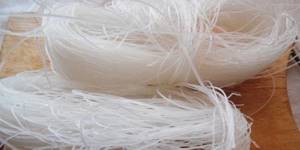
Calorie content
Starch noodles in dry form have a calorie content of 320 kcal/100 grams, in boiled form - 82 kcal/100 grams, with a low glycemic index (the rate of absorption of carbohydrates). Is funchose high in calories? Bean noodles themselves are a dietary product because they have minimal fat content. In rare cases, manufacturers add soy or buckwheat, but this has virtually no effect on calorie content or taste. Although the calorie content of funchose is high, it is recommended for overweight people, since it is made from bean flour, which does not harm the figure.
Rice noodle dishes for weight loss
Here are some delicious and easy to prepare dishes you can prepare:

1. Rice noodles with mushrooms and herbs. You will need: noodles (150-200 grams), boiled any mushrooms (300 grams), cherry tomatoes (150-200 grams), onions (1-2 pcs.), garlic, cilantro, dill, green onions, vegetable oil ( 1 tbsp), salt, spices. Preparation: lightly fry the mushrooms, onions, garlic and cherry tomatoes (whole). When the mushrooms are ready, sprinkle them with herbs. Next, prepare the noodles: lower them into boiling water for about 4-5 minutes. Add mushrooms to the finished rice noodles, mix everything thoroughly and the dish is ready! Tip: you can add a tablespoon of low-fat sour cream to the dish.


Preparation: cook the rice noodles, then cool. We put shrimp, sauerkraut and all the greens (except basil) in it. Separately, make cucumber sauce using a blender (cucumbers plus garlic plus basil, lemon juice and a little vegetable oil). Pour the finished sauce over the noodles, add salt and pepper, mix well, and enjoy this unusual and tasty salad! If you have never tried rice noodles, be sure to try them, as they are not only tasty, but also healthy!
Rice Noodle Recipes
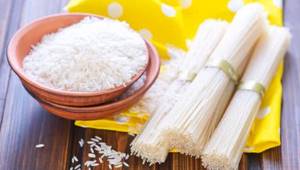
Asparagus Casserole
For the casserole - 400 g of asparagus, 400 g of boiled rice noodles, 200 g of pollock fillet, optional carrots or bell pepper, and ground black peppercorns, 40 g of hard cheese and a tablespoon of soy sauce. Additionally - a baking dish.
Rice noodles are boiled separately. Rice noodles are placed on the bottom of the baking dish, followed by pollock fillet, vegetables, each layer is “laid” with a small portion of a mixture of cheese and soy sauce. The dish is baked at 180 degrees for 30-40 minutes and served hot.
Rice noodle salad
200 g each of shrimp and squid, 300 g of boiled rice noodles, any green leaf lettuce, such as romaine, or even kale, a tablespoon of sour cream, a teaspoon of creamy mustard or mustard powder, fresh cucumber.
Boil shrimp, squid and noodles and cool in a colander. Mix sour cream with mustard powder or mustard, chop fresh cucumber, chop or disassemble the salad by hand, mix all the ingredients of the dish in a deep salad bowl, and leave in the refrigerator for 20-30 minutes before serving.
Rice noodles with oriental beef
8 prunes, 1 carrot, red onion, a glass of vegetable broth, red pepper, ginger, cinnamon, sesame oil, sea salt, 300-400 g of glass or boiled rice noodles, 400 g of cauliflower, and 200 g of beef.
Chop all the vegetables and prunes, quickly fry in sesame oil along with spices, mix in a deep frying pan, and add beef. Add vegetable broth, reduce heat, close the lid and simmer over low heat until the meat is cooked. Add rice noodles, stir.
Rice noodle soup with squid
150 g raw peeled squid, rice noodles, 1 standard portion or 30-40 g dry, seaweed, white onion, carrots, miso soup base, sweet potato tuber.
Dissolve the base for miso soup in water, add shredded squid, sweet potato tuber, and cook until tender. Crush the seaweed and add it to the finished dish.

Spicy rice noodles with bean paste
For bean paste - a can of canned red beans, a white onion, black pepper on the tip of a knife, 1 cm of ginger root, and red pepper if desired, olive or sesame oil. For the main course, 4 servings of rice noodles, soy or teriyaki sauce, or sea salt.
Heat the oil over low heat in a deep frying pan, add spices and continue heating, add beans. Then grind the beans with spices into a paste in a blender. Cool. Boil the rice noodles, drain in a colander, then add soy sauce or salt to taste.
So, rice noodles are an excellent choice for those looking for an inexpensive and tasty side dish, they allow for experimentation in the kitchen and can be combined with many types of foods.
Is it possible to lose weight on funchose?
Nutritionists say that funchose can replace any side dish on a diet. The body is saturated with vitamins, and fat burning occurs faster when consumed.
Funchoza when losing weight - is it possible or not?
Glass noodles as a low-calorie side dish with the addition of poultry and vegetables speed up metabolism and enrich the body with energy. It has practically no side effects, is well absorbed, removes toxins and bad cholesterol. Losing weight is non-exhausting, reasonable, and, at the same time, fast. Nutritionists recommend that people losing weight not doubt whether funchose can be on a diet, but feel free to include it in their diet.

How to cook funchose
It's easy to prepare a delicious bean noodle dish at home. First you need to place it in warm water for 10 minutes, when it swells, put it in boiling unsalted water, boil for 3-5 minutes. Ready noodles can be added to soup, used as a side dish for fried chicken, turkey, shrimp, fish or pickled vegetables. You can make an unusual spicy Korean salad with soy sauce, carrots and sweet peppers. Cooking funchose will give you a subtle nutty aroma; serve it hot.
How to choose real Chinese noodles (fantasy in the original):
- study the composition;
- pay attention to the color - it may be slightly grayish, transparent, without a yellow tint;
- noodles are very fragile, regardless of the thickness of the threads;
- the threads are all separated, not stuck together;
- no smell;
- thread width up to 3 mm, length at least 50 cm.
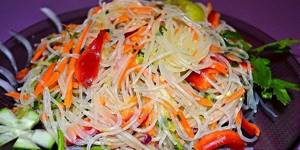
The benefits and harms of glass noodles?
The benefits of funchose cannot be overestimated. Its composition is a storehouse of vital vitamins and mineral salts. People who follow a gluten-free diet especially appreciate the lack of gluten.
Funchoza helps maintain skin elasticity and strengthen the nervous system. Reduces blood sugar levels, strengthens the skeletal system, normalizes intestinal function, and strengthens the vascular wall.
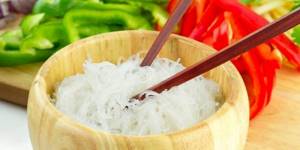
Unscrupulous manufacturers, in an attempt to save on raw materials, make glass noodles from corn starch with the addition of bleaches and taste improvers. This product is not recommended for consumption due to its negative effects on the digestive system.
Composition and calorie content of noodles
Glass noodles are made from mung bean starch. This member of the legume family is similar to green peas. Starch from other plant crops can also be used: manufacturers often began to use rice and potatoes. The taste depends on what the product is made from. The taste of these noodles is not very pronounced.
The advantage of this side dish is the absence of gluten, which makes the noodles safe for people with an allergic reaction to this substance. When consumed, there is no sharp jump in glucose, which is an advantage for patients with diabetes. The product contains vitamins B1, B6, E. Microelements include zinc, calcium, selenium, iron, magnesium and phosphorus.
Dry funchose contains from 360 to 320 kcal per 100 g. Boiled in 100 g of a dietary dish without additives it contains from 78 to 90 kcal. Of this, carbohydrates account for approximately 20 g. The amount of proteins and fats is small.
Types of funchose
Funchoza is perhaps one of the most famous dishes of Asian cuisine, which has gained great popularity in Europe, which is “glass” noodles with vegetable and meat additives.
Noodles are made from starch raw materials - potato, legumes. Calling it pasta is incorrect. Funchose is often confused with rice noodles, but rice vermicelli does not become translucent.
Rice funchose
Russian buyers are often mistaken in believing that rice noodles and funchose are the same product. The difference can be noticed after boiling - rice noodles become richly white, and real funchose becomes transparent as ice.

Bean funchose
Nutritionists recommend bean glass noodles due to their unique nutritional value, low carbohydrate (84 g) and low fat (0.5 g) content per 100 g of noodles. It is made from mung bean starch. Bean udon is recognized as a dietary product; it contains the most complete list of beneficial vitamins:
- B1 (thiamine), slows down the aging process, vitamin of good spirits and optimism;
- B2 (riboflavin, lactoflavin), eliminates disruptions in intestinal function, saturates blood vessels and nerves;
- B5, participates in the production of energy by cells;
- PP, helps break down fats and carbohydrates, reduces cholesterol levels in the blood;
- phosphorus, strengthens the body, together with calcium forms the structure of bone tissue;
- calcium, a building element, is responsible for the growth of teeth and hair, and takes part in all metabolic processes;
- zinc, balances hormonal levels, accelerates cell restoration, affects skin condition;
- iron, improves metabolism, is part of hemoglobin, and participates in respiratory processes at the cellular level.
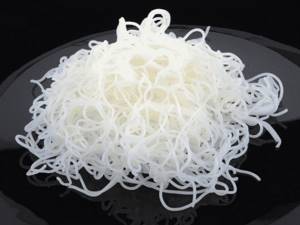
Potato funchose
Mung beans are an expensive ingredient, so funchose is often made from potato starch. Chinese chefs are guilty of adding bleaches to the dish to give the product a marketable appearance. Such additives are harmful to the body as they contain lead and aluminum.
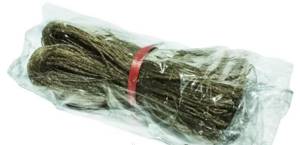
Funchoza for weight loss
Many people wonder whether it is possible to eat funchose on a diet when they find out the number of calories in a dish. Regular pasta is prohibited for consumption in most nutrition systems for losing weight, but the difference with glass noodles is their low-calorie content when cooked compared to the pasta products we are used to. According to nutritionists, when on a diet, funchose becomes an excellent substitute for almost any side dish. If you replace potato dishes with a portion of starchy noodles with dietary meat, the process of “burning” fat will begin to gain momentum.
Glass noodle diet
Nutritionists and people who have successfully lost weight have long been convinced of the effectiveness of glass noodles. The doubt that tormented overweight people - whether funchose was dietary or not - evaporated like smoke. Numerous positive reviews confirm this.
Many diets have been developed based on dishes with funchose; the most popular is the five-day diet. With its help, you can get rid of 3-5 kg in five days, the body is cleansed of toxins, and the skin takes on a radiant appearance.
The diet is strict, excludes the consumption of sugar and fast carbohydrates, therefore it is recommended to spend a five-day period on glass noodles once every 3 months, and on the remaining days to adhere to proper nutrition.
To get out of the diet painlessly, you need to gradually add meat broths, cottage cheese, fruits and vegetables to your diet.

If you combine physical activity (running, walking, cycling) with proper correction of your diet, the result of an excellent figure and wonderful mood will be quickly noticed by others.
Girls are afraid to gain weight on glass noodles, but their fears are unfounded.
When losing weight, funchoza goes perfectly with vegetables, so the noodles are supplemented with sweet peppers, carrots, and garlic. During the diet, it is good to add boiled chicken to the dish. You can season with oil for taste, but you need to carefully ensure that the dressing does not harm your diet.
If the diet is long-term, then the diet can be diversified with funchose. Besides the many variations of noodles and vegetables, udon soup is a good alternative.

Main diet recommendations:
- avoid funchose-potato combinations due to increased satiety and increased volume of starch;
- It is recommended to eat vermicelli in the morning and at lunch; it is better not to eat it in the evening.
Funchoza during fasting
In the culture and religion of many peoples there are fasts during which various restrictions apply. Quite often there are bans on the consumption of animal products.

Funchoza is a product made from plant ingredients. Since it goes well with vegetables, sauces and seasonings, it will be convenient for you to diversify your menu.
During fasting, calories are especially important to people. Rice noodles will help you obtain the required amount of microelements.
Nowadays, many people are very concerned about healthy eating. They are actively looking for healthy and low-calorie foods. Funchose is an irreplaceable component, the taste and other beneficial properties of which have been tested for centuries. Over time, it will take its place on the menu of every family. Bright and varied dishes with noodles will decorate our tables both on weekdays and on holidays. If you haven’t tried funchose yet, then you should be culinary adventurous and prepare something tasty and healthy from it for the whole family. Don't be afraid to experiment!
Glass noodle diet, reviews
Girls and women who dream of losing weight share rave reviews on forums and blogs. The results of losing weight are impressive. The main advantages they note:
- Tasty, satisfying;
- There is no feeling of hunger for a long time;
- Lose 2-3 kg in one to two weeks.
Noodles are combined with fresh and boiled vegetables, sprouted grains, meat, olive oil, shrimp, and soy sauce.
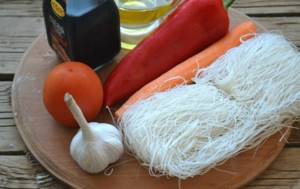
Fans of Asian cuisine are distinguished by their slimness, lightness and love of life. When the intestines work correctly, excess weight does not provoke edema and depression, life seems much better. Glass vermicelli is a dietary product. It is worth trying if you need to lose excess weight and improve your health. It is inexpensive, easy to prepare, and surprisingly healthy.
Useful properties of funchose
The oriental dish is easily digestible and does not overload the digestive system. The internal tone of the gastrointestinal tract improves: noodles stimulate the functioning of the stomach and intestinal motility. Promotes the removal of toxins, toxic, poisonous substances from the body. With regular use, it helps to normalize the water-salt balance of the body. Stimulates metabolic processes, accelerates metabolism. Even a small portion is enough to satiate you, because the complex carbohydrates included in the composition take a long time to break down in the intestines.
The process of cell renewal accelerates, which has a positive effect on the condition of the skin. The skin becomes smoother, more elastic, and turgor improves. Funchose is also useful for nails and hair.
Good for diabetics. The product has a low glycemic index, so it has almost no effect on blood glucose levels. Noodles provide vitamins and minerals and help improve your mood. Reduces the risk of developing thrombophlebitis, reduces the likelihood of hemorrhage in the heart and brain, and prevents the appearance of diabetic foot.
The development of cancer is slowed down. Noodles slow down the loss of visual acuity. In men, it prevents a decrease in potency. Helps strengthen the skeleton.
There is little cholesterol in the dish. Atherosclerotic plaques do not form. This makes such food safe for hypertension. Red blood cells carry oxygen better and supply body tissues with this gas.
Pregnancy, lactation, and childhood are not contraindications for eating funchose. It is better, however, to abandon traditional sauces, since they are high in calories, contain a large number of components, and can cause unwanted reactions.
Only original funchose, which does not contain foreign impurities, will bring benefits. It is necessary to carefully check the composition before purchasing. In addition, if possible, you should inspect the noodles themselves. It shouldn't be sticky. Good glass noodles are fragile and break without effort. There is no smell. It is better to take a dry product to prepare yourself, since store-bought salads are often seasoned with a large amount of oil, which is why they become excessively high in calories.
Noodle production

The product manufacturing process consists of two stages. First, workers knead the dough using only flour and water, without adding salt. The second depends on the preference of the manufacturer.
The latter chooses one of five actions:
- cutting - the rolled out layer is divided into strips of the required size;
- extrusion - the dough is placed under a press with holes and thin identical threads are obtained;
- cutting - a sausage is formed from the resulting mass, and then thin petals are cut off from the top, which fall into boiling water;
- folding - a cylinder is made from the dough, then it is folded and rolled out again, the action is repeated several times;
- rolling - a thread of the required size is formed from a small piece of mass.
Fresh rice noodles are dried and then packaged and sold. Based on the description of the production, you can see that there is no harm to the product. In theory, there can be nothing bad in water and flour. But there are some nuances here, which we will discuss below. Now another question is important - what is the benefit of the product?
Does it happen that there is no harm?
Yes, sometimes. Rice noodles are an ideal choice for those who are watching their health and weight. It belongs to a small group of food products that have no contraindications for consumption. Of course, prepared without sauces and fried vegetables/meat or other extremely unhealthy and high-calorie additives.
Moreover, nutritionists around the world strongly recommend including this healthy product in your daily diet. The absence of gluten completely eliminates even the slightest possibility of an allergic reaction, and the presence of eight essential amino acids in rice noodles promotes the formation of new cells.
Sources:
https://polzaivredno.ru/risovaya-lapsha-polza-i-vred/ https://foodandhealth.ru/muchnye-izdeliya/risovaya-lapsha/ https://onwomen.ru/risovaya-lapsha.html
How to store and eat rice noodles
You can buy a ready-made product, or you can prepare it yourself if you purchase all the ingredients. Homemade noodles are stored in a dry place at room temperature, like regular pasta.
The purchased finished product is stored in a cool, dry place without strong odors. High moisture levels can ruin the quality of the noodles. A thick bag or plastic container is suitable for storage. It is recommended to use it within 1-2 days . It is best to buy small portions.
You can add seafood, boiled or smoked chicken to Chinese noodles. Vegetables that go well with it are fresh cucumbers, bell peppers, radishes and carrots. All this is added while the noodles are still hot.
No seasoning is added to the rice product so as not to drown out the delicate taste. The Asian dish perfectly absorbs aromas, flavors and colors. Because of this, noodles are added to many recipes.
The product can be used for preparing hot and cold dishes. Cold appetizers are considered more delicious.
Chinese rice noodles are a tasty and healthy product . Its properties improve the functioning of the entire body. The product is widely used in cooking: from hot soups to vitamin salads. You can prepare it yourself if you know the recipe and purchase the necessary ingredients. The finished product is sold in many stores. Asian cuisine is gradually gaining popularity in world cuisine.
Product calculator
Enter the amount of Rice Noodles to calculate its nutritional value
| Property | Meaning | % of normal | |
| Calorie content, kcal | 364 | 18.2 | 18.2% |
| Proteins, g | 3,44 | 2 | 2% |
| Carbohydrates, g | 81,64 | 32.4 | 32.4% |
| Fats, gr | 0,56 | 0 | 0% |
Caution in use
Rice noodles can be harmful if you eat them too often and add fatty meat, fish or dressing to your dishes. Firstly, the product has a strengthening effect on the gastrointestinal tract, which can cause constipation. Therefore, it is better for people with such a problem not to use the product.
Secondly, various additional components increase the calorie content of the dish, which can lead to excess weight gain. Another problem is that unscrupulous manufacturers may add various additives to the composition to reduce the cost of the manufacturing process. Such a product will only cause harm, since only enterprise employees know what is contained in their product.
Micro- and macroelements in Rice Noodles
Rice noodles contain the following elements: SFA - Saturated fatty acids, Ash, Water, Dietary fiber, Sodium, Potassium, Phosphorus, Magnesium, Calcium, Copper, Manganese, Selenium, Zinc, Iron.
| Micro and macro element | Meaning |
| SFA – Saturated fatty acids, g. | 0,153 |
| Zola, Mr. | 0,85 |
| Water, city | 11,91 |
| Dietary fiber, g. | 1,6 |
| Sodium, mg | 182 |
| Potassium, mg | 30 |
| Phosphorus, mg | 153 |
| Magnesium, mg | 12 |
| Calcium, mg | 18 |
| Copper, µg | 78 |
| Manganese, mg | 0,498 |
| Selenium, mcg | 15,1 |
| Zinc, mg | 0,74 |
| Iron, mg | 0,7 |
Is it possible or not to eat funchose when losing weight, its calorie content and properties for weight loss
There are 2 varieties of rice noodles - regular and funchose. Some call it glass noodles, but this is incorrect. Classic glass noodles are made from mung bean starch. Rice noodles contain only 2 ingredients - rice flour and water. Rice noodles are completely fat-free.
The product is in great demand among fans of a healthy lifestyle, which is not surprising, because unlike wheat pasta, rice noodles do not contain gluten. This means that it does not cause allergies and can be consumed by people of all age groups. Interestingly, the Chinese, who cannot imagine their menu without these noodles, try to make them as long as possible, because they believe that the longer the noodles, the longer life. Many people confuse rice noodles with funchose, which is similar in appearance, although the latter is made from mung bean and after cooking it remains transparent.
Therefore, it is an excellent product for hypertensive patients, those for whom fats cause indigestion and liver problems. Rice noodles are an additional source of vegetable protein. It is noteworthy that if you combine this product in your diet with legumes, you can get a more complete amino acid composition than other vegetarian products.
This is often used in the diet by strict vegans who do not consume milk or eggs. Rice noodles contain a lot of complex carbohydrates. This is a unique component of our diet. All energy in the human body comes from complex carbohydrates.
It nourishes the body and brain.
Useful properties of rice noodles
If you consume them regularly and in adequate quantities, you can get rid of slow metabolism. The human body needs about 4 g of carbohydrates on average per 1 kg of weight, and for an active life - about 5 g. The complex carbohydrates of rice noodles are absorbed quite quickly; this product has a high glycemic index. It is useful in the nutrition of athletes, allowing them to quickly restore energy after training. If we are talking about a normal healthy lifestyle, you can prepare mixed dishes from noodles and protein sources, and lower the glycemic index of the finished dish.
In addition, there is no scientific evidence that foods with a high glycemic index are harmful to a healthy person. Restrictions on their use apply only to patients with diabetes. Rice noodles are considered a good supplemental source of vitamins and minerals. It contains a rare vitamin PP, the deficiency of which has a detrimental effect on the functioning of the nervous system and can even lead to serious nervous disorders.
Rice noodles contain a complex of B vitamins necessary for normal metabolism and proper functioning of the nervous system. B vitamins are also necessary for anyone who strives to maintain heart muscle health. They play an important role in muscle recovery after physical activity.
Rice noodles contain the rare mineral selenium, which is involved in metabolism and speeds it up. Selenium is essential for the normal functioning of the brain, muscular system and nervous system as a whole. The product contains a small amount of diheme iron, its use helps to replenish iron deficiency and allows you to have a normal hemoglobin level.
Everyday food with some iron content helps prevent iron deficiency anemia almost to a greater extent than taking special medications.
Rice noodles contain potassium and sodium, the use of which helps normalize water-salt balance and relieves swelling. These minerals also serve as an excellent prevention of cramps and swelling during a salt-free diet. The product also contains small amounts of magnesium, which is beneficial for the heart and nervous system.
Some sources claim that rice noodles are harmful. For example, it is often blamed for someone gaining weight. Here you can see that the noodles themselves have nothing to do with it. It's usually overeating that causes weight gain, not the foods we overeat.
The only exceptions are people who have diabetes and therefore cannot eat foods with a high glycemic index. Prediabetics should not eat noodles, as their condition may also be affected by eating high-glycemic foods. It is sometimes written that eating rice causes calcium to be washed out of the bones, but this is not true. Rice noodles may not be healthy if a person's diet is not balanced. Rice noodles are a quick-cooking product.
Rice noodles are usually sold in the Asian food section. It is a traditional product for Southeast Asia and Japan. Rice noodles are the staple of the diet in many countries. The product has an average calorie content and is a source of complex carbohydrates and vitamins. The big advantage of rice noodles for an experienced cook is that they can be filled with almost any flavor.
It is immersed in boiling water and cooked for minutes. Then it is thrown into a colander and dried. After this, you can add various vegetables, chopped fish, meat, shrimp, mussels, and other products to the rice noodles. Some sources claim that rice noodles are not suitable for weight loss because they are high in calories.
Boiled rice noodles contain about kcal per g, which cannot be considered high in calories. But problems with rice noodles can still occur in a person who has altered cell sensitivity to insulin.
For such people, even a moderate portion of noodles can cause a significant increase in appetite. This leads to the fact that people often suffer from overeating, as soon as they introduce at least one serving of noodles into their diet.
So, of course, it is better to eat noodles occasionally or completely eliminate them. Everyone else can prepare low-calorie rice noodle dishes with the addition of shrimp, squid, mussels, chicken breasts and other sources of low-fat protein. The benefits of funchose cannot be overestimated. Its composition is a storehouse of vital vitamins and mineral salts. People who follow a gluten-free diet especially appreciate the lack of gluten.
Funchoza helps maintain skin elasticity and strengthen the nervous system.
Reduces blood sugar levels, strengthens the skeletal system, normalizes intestinal function, and strengthens the vascular wall. Unscrupulous manufacturers, in an attempt to save on raw materials, make glass noodles from corn starch with the addition of bleaches and taste improvers.
This product is not recommended for consumption due to its negative effects on the digestive system. Glass vermicelli is a godsend for people with excess body weight.
Nutritionists insist on regularly including it in the daily diet; it has a beneficial effect on the body and promotes rapid weight loss. If you follow the portion norm, then an ordinary plate with funchose will not lead to fullness.
Noodles are made from starch raw materials - potato, legumes. Calling it pasta is incorrect. Funchose is often confused with rice noodles, but rice vermicelli does not become translucent.
Russian buyers are often mistaken in believing that rice noodles and funchose are the same product. The difference can be noticed after boiling - rice noodles become richly white, and real funchose becomes transparent as ice. Nutritionists recommend bean glass noodles due to their unique nutritional value, low carbohydrate content of 84 g and fat content of 0.5 g per g of noodles.
It is made from mung bean starch.



